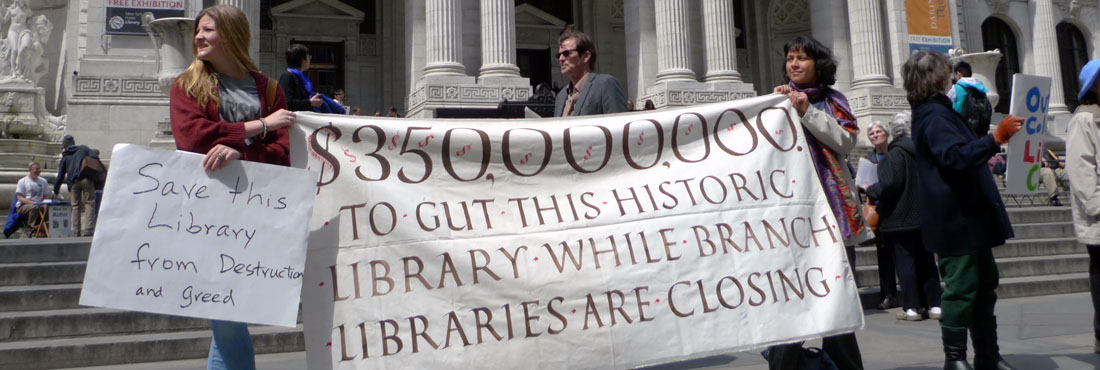“I am calling on the City to halt the New York Public Library’s plans at the Central Library, and for a thorough, independent cost audit and review of the proposed project…This review should evaluate the complete financial risks associated with the current plan, and seriously consider alternative ways to use City funds to ensure the preservation of the NYPL’s valuable collection stored at the Central Library and preserve the Mid-Manhattan branch as a functioning library.”
– NYC Mayor Bill de Blasio during his campaign, July 12th, 2013
After widespread opposition led by our group, NYPL abandoned their Central Library Plan in 2014. NYPL has agreed to complete the storage facility under Bryant Park and return 2.5 million books, making them quickly accessible to readers, but the stacks remain empty leaving 3 million books in remote storage.
The Central Library Plan (CLP), at enormous cost to New York City and its taxpayers, would have irreparably damaged the 42nd Street Research Library – one of the world’s great reference libraries and a historic landmark. The CLP also called for the sale of the Mid-Manhattan Library at 40th and Fifth Avenue, the most heavily used library in the entire country.
The NYPL planned to demolish the 42nd Street Library’s historic seven-story book stacks, install a circulating library in their stead, and displace 1.5 million books to central New Jersey. The new circulating library would have replaced the Mid-Manhattan Library and the Science, Industry and Business Library (at 34th and Madison), despite being less than one-third the size of the two existing libraries.
This plan was created through a closed process with no public input, and has been condemned by leading architecture critics.
• It would have cost over $500 million, of which $150 million will come from New York City taxpayers. There is great concern that the Library’s focus on a highly-complex construction project will absorb desperately-needed funds which might otherwise pay for renovations of branch libraries, and replenish slashed curatorial and acquisitions budgets.
• It would have jammed patrons of the circulating library into a space one-third the size of the existing Mid-Manhattan Library and SIBL.
• It would have threatened the 42nd Street Library’s role as one of the world’s great research libraries.
• It would have threaten the architectural integrity of the landmarked 42nd Street building.
• It did not take into consideration more efficient and less destructive alternatives, such as combining SIBL and the Mid-Manhattan into a rehabilitated and expanded building on the Mid-Manhattan site.
The NYPL administration allowed no opportunity for public participation or oversight when they formulated this project. Despite the fact that the 42nd Street building is owned by the city and is one of our most iconic structures, the $150 million that the city had earmarked for the plan was awarded without oversight by the City Council and with no public hearings. If alternatives had been considered they have never been disclosed, and no cost-benefit analysis or detailed budget has ever been presented.
Famed architecture critic Ada Louise Huxtable, writing in the Wall Street Journal, attacked the Central Library Plan as
a plan devised out of a profound ignorance of or willful disregard for not only the library’s original concept and design, but also the folly of altering its meaning and mission and compromising its historical and architectural integrity. You don’t ‘update’ a masterpiece.
New York Times architecture critic Michael Kimmelman derided the design for the new circulating library which would have replaced the book stacks in the 42nd Street building as having “all the elegance and distinction of a suburban mall,” and called it an
awkward, cramped, banal pastiche of tiers facing claustrophobia-inducing windows, built around a space-wasting atrium with a curved staircase more suited to a Las Vegas hotel.
The Committee to Save the NYPL called for a halt to the CLP until an independent agency can conduct a detailed cost analysis. This analysis should also evaluate the costs of an alternative proposal suggested by both Huxtable and Kimmelman that the 42nd Street building be left intact and attention directed instead to a renovation of the Mid-Manhattan building. As Kimmelman writes, “A new Mid-Manhattan branch should cost a fraction of gutting the stacks and could produce much better architecture.”
For an in-depth analysis of the Central Library Plan, please see The Truth About the Central Library Plan.

